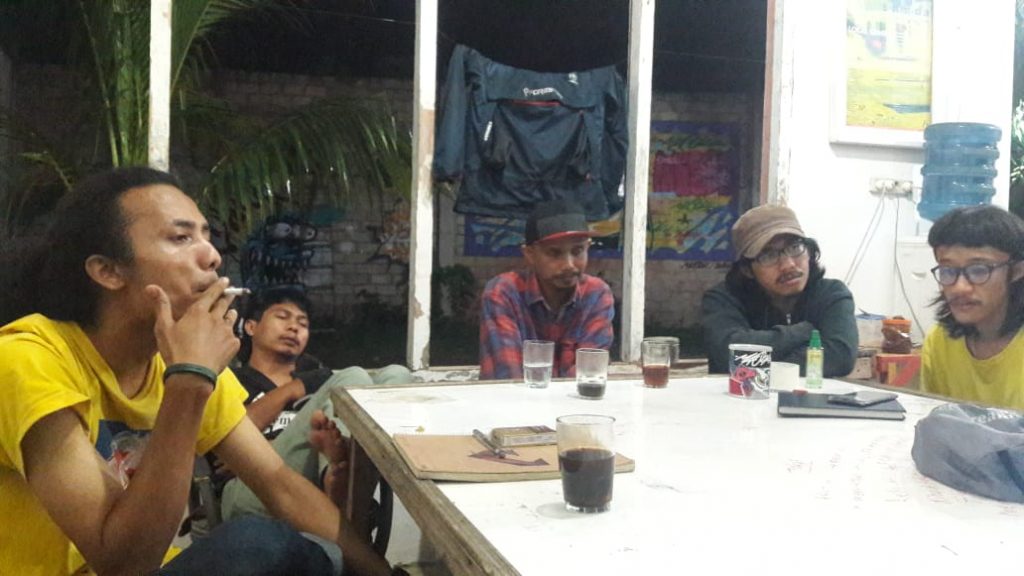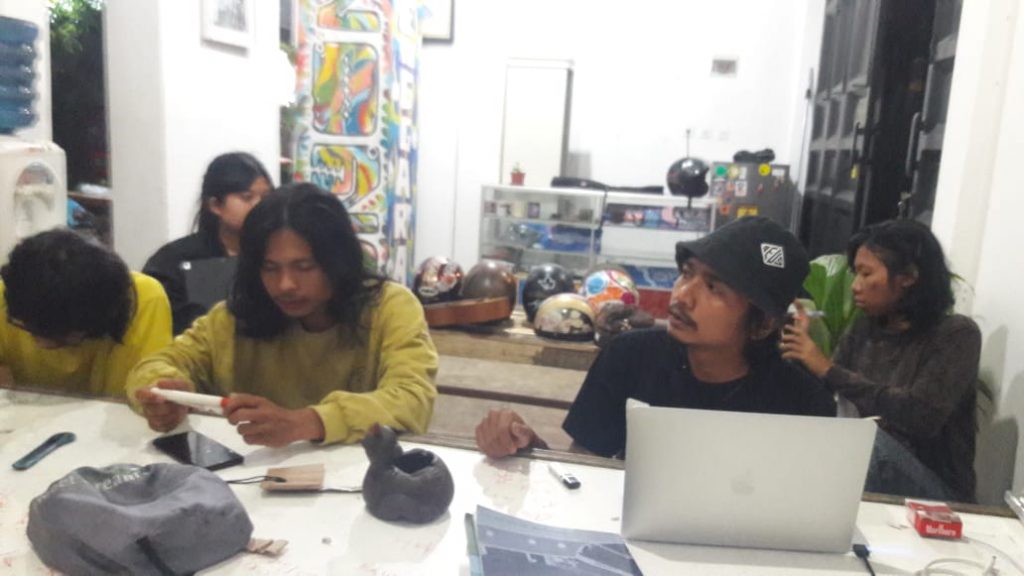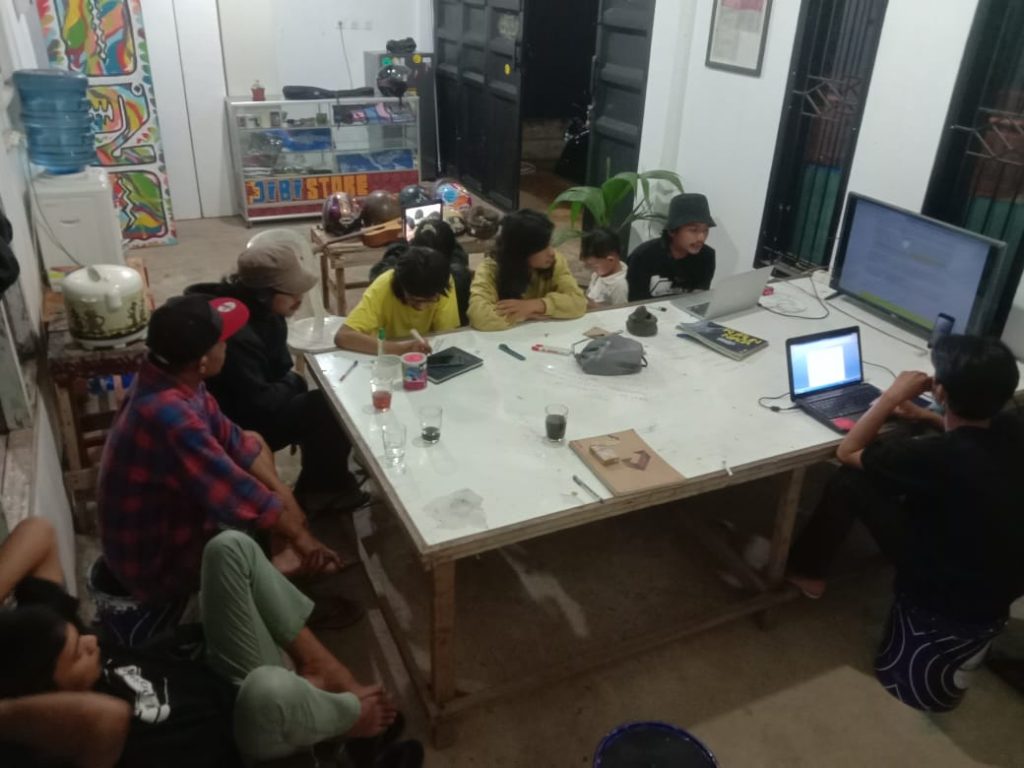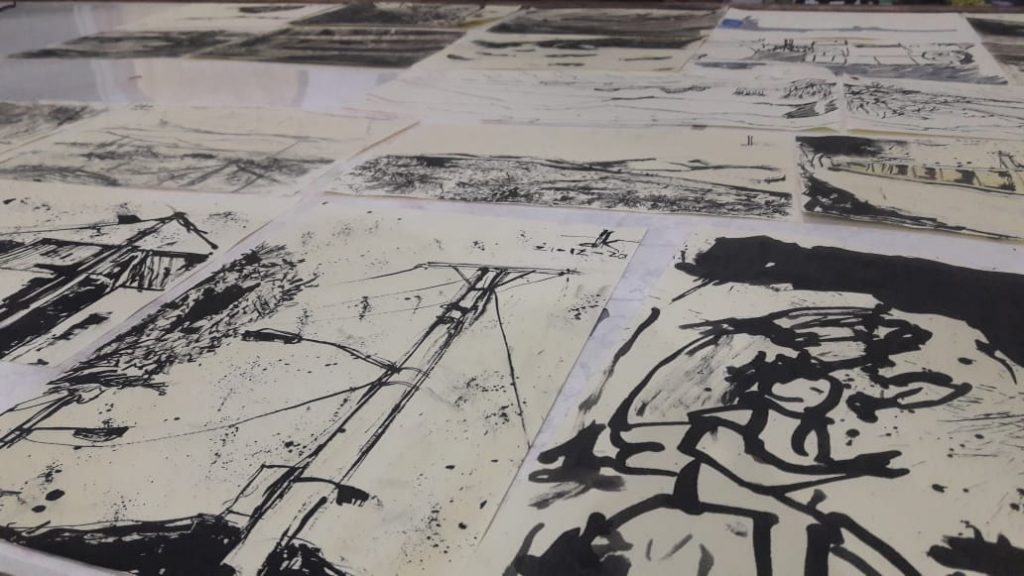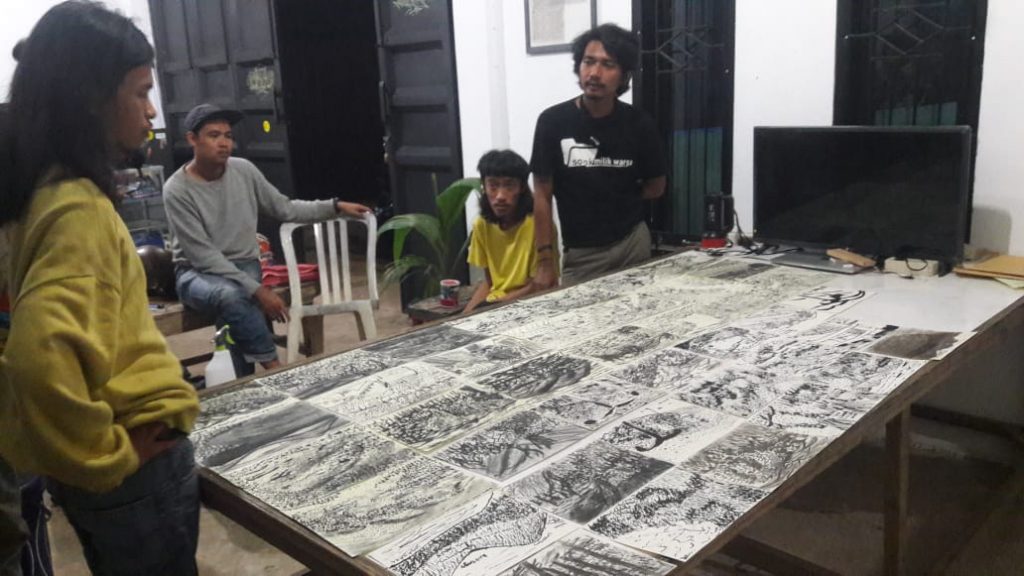[Scroll for English]
Kamis, 25 Desember 2020, teman-teman kembali berkumpul di kabin tengah Rumah Tamera. Berkumpul kali ini adalah dalam agenda diskusi terarah, menyatukan presepsi, dan meninjau proses sketsa yang dilakukan oleh teman-teman 3 minggu terakhir untuk proyek Kurun Niaga. Sebelumnya, para partisipan proyek: Anggraeni Widhiasih (Jakarta), Autonica (Yogyakarta), Verdian Rayner (Solok), Volta A Jonneva (Kinari), Teguh Wahyundri (Solok) Boynistill (Solok), BDX (Solok), dan para fasilitator: Albert Rahman Putra (Solok), Biahlil Badri (Solok), Biki Wabihamdika (Solok), telah mengunjugi beberapa titik di Solok dan Kota Sawahlunto untuk memproduksi sketsa.
Di Solok, para partisipan bolak-balik ke beberapa titik tinggi, seperti, Angin Berhembus Aripan, Payo, Gor Batu Batupang, dan lainnya. Di titik tinggi tersebut para partisipan melihat lanskap Solok, dengan kesadaran yang beragam. Sebagian besar cara pandang ini dikunci oleh narasi perniagaan di Solok, dari catatan proyek Kurun Niaga sebelumnya. Dalam hal ini, fasilitator menerangkan beberapa dimensi waktu berdasarkan jalur perniagaan di Solok dan sekitarnya.
Dimensi waktu itu antara lain, jalur setapak dan jalur setelah penemuan batu bara Ombilin, yang terpusat di Kota Sawahlunto. Perubahan jalur ini turut membentuk garis-garis alam Solok hari ini. Dari atas kita bisa melihat beberapa pola pemukiman warga saling tarik ulur dengan kontur alam, pola kemunculan titik-titik baru, dan vegetasi umum di Solok.
Diskusi ini dibuka oleh Albert, selaku fasilitator serta kurator project, dan dilanjutkan oleh para partisipan yang saling berbagi hasil pengamatan. Volta yang juga terlibat pada proyek Kurun Niaga sebelumnya, melihat praktik beberapa minggu ini sebagai pengalaman yang berbeda baginya. Ia juga merupakan anak muda yang besar di Solok. Titik-titik tadi sebenarnya bukanlah hal baru baginya, tapi dengan kesadaran akan proyek Kurun Niaga ini, ia melihat kontur alam dan pemandangan ini dengan cara yang lebih berbeda. Impresi serupa juga dialami oleh kawan-kawan yang berasal dari Solok.
Badri, yang juga terlibat di Kurun Niaga sebelumnya, menyadari bahwa perubahan pemandangan pasca-kolonialisasi tidak hanya terjadi pada lanskap dan titik kumpul, tetapi jika kita “zoom“, perubahan juga terjadi pada pola arstitektur dan tata ruang, seperti rumah-rumah yang membelakangi sungai, dan sebagainya.
Verdian adalah partisipan dari Solok yang tidak ikut proyek Kurun Niaga sebelumnya. Di ketinggian, dalam proses sketsa yang membutuhkan waktu itu, membuat ia membayangkan titik-titik di bawah tersebut sebagai puzzle, dengan imajinasinya ia serasa ingin memindahkan dan menyusun ulang puzzel itu susuai susunan ideal menurut pikirannya.
Sementara itu, Autonica, yang sudah lebih satu bulan di Solok, melihat pemandangan itu menyisakan sejumlah cerita-cerita yang terputus, ada banyak peristiwa di bawah sana yang belum terceritakan. Begitu pula dengan Anggra, sebagai orang yang bukan besar di Solok, ia mengantisipasi sudutpandangnya agar tidak terjebak dalam situasi eksotisasi. Butuh waktu yang sangat panjang untuk dapat memetakan Solok dengan lebih baik. Namun, dalam konteks proyek ini, sketsanya menangkap sejumlah aspek antropologis dan bisa merasakan sejumlah perubahan lanskap tersebut. Momen yang paling berkesan bagi Anggra adalah ketika mengunjungi Kota Sawahlunto. Sebuah kota yang dibangun di atas sungai dan sawah setelah penemuan Batu Bara.
Diskusi ini memperkaya pandangan masing-masing partisipan yang terlibat dalam proyek ini. Albert juga menghubungkannya dengan tradisi lukis “Mooi Indie” (Hindia Molek) atau kebiasaan melukis keindahan pemandangan alam yang cukup berkembang di Sumtera Barat sejak masa kolonial. Banyak tokoh-tokohnya muncul di Sumatera Barat. Dalam beberapa kajian yang dipaparkan Albert di layar TV, sebagian besar praktik ini sering kali merekam keindahan alam, mengedepankan kedetilan, kemiripan, dan keunggulan teknis realis, serta cenderung membingkai objek-objek untuk kebutuhan pajangan untuk publik Eropa. Bahkan beberapa lukisan Wakidi misalanya, menghilangkan beberapa objek modern.
Dalam kurasi Kurun Niaga ini, kita lebih menekankan proses membaca ulang sejarah, menghubungkan diri, dan menangkap aspek pengetahuannya. Pembacaan ini diharapkan dapat menjadi tawaran mengisi kekosongan narasi sejarah dan menjadi alternatif sudut pandang melihat persoalan ataupun potensi lokal. Bereksperimen tentang kemampuan praktik seni sebagai medium riset.
Diskusi ini ditutup dengan menentukan beberapa sketsa yang perlu kita lengkapi untuk kebutuhan presentasi publik atau open lab. Presentasi ini akan disajikan untuk memantik respon publik terhadap tema yang diusung, yang akan digelar 28 Desember 2020, di Rumah Tamera.
–
Solok in The Dimension of Commerce
Thursday, December 25, 2020, our friends gathered again in the middle cabin of Rumah Tamera. Our gathering this time is in the agenda of a focus group discussion to unify perceptions and review the sketching process done by our friends in Gubuak Kopi in the last 3 weeks for the Kurun Niaga project. Previously, the project participants: Anggraeni Widhiasih (Jakarta), Autonica (Yogyakarta), Verdian Rayner (Solok), Volta A Jonneva (Kinari), Teguh Wahyundri (Solok) Boynistill (Solok), BDX (Solok), and facilitators: Albert Rahman Putra (Solok), Biahlil Badri (Solok), Biki Wabihamdika (Solok), have visited several locations in Solok and Sawahlunto City to produce sketches.
In Solok, the participants went back and forth to several high locations, such as Angin Berhembus in Aripan, Payo, Gor Batu Batupang, and others. At these high locations, the participants saw Solok’s landscape with different kinds of awareness. Most of this perspective is locked by the narrative of commerce in Solok from the previous archives of the Kurun Niaga project. In this case, the facilitators explained several time periods based on the trade routes in Solok and its surroundings.
The time periods among other are the pedestrian route and the route after the discovery of Ombilin coal, which was centred in the city of Sawahlunto. These changes of route have helped in shaping Solok’s natural lines today. From above, we can see several patterns of residential areas that negotiates with natural contours, patterns of the emergence of new spots, and general vegetation in Solok.
This discussion was opened by Albert, as a facilitator and project’s curator, and continued by the participants to share the result of their observation. Volta who was also involved in the previous Kurun Niaga Project saw the practice in these several weeks as a different experience for him. He is also a young man who grows up in Solok. The aforementioned locations are not a new thing for him, but in the frame of Kurun Niaga Project, he saw the natural contour and the landscape scenery in a different way. The same impression was also experienced by other participants from Solok.
Badri who was also involved in the previous Kurun Niaga Project realized the change of the post-colonized landscape did not only happen to the landscape and the hotspot. However, if we zoom it, the change also happened in the pattern of city architecture and design, such as the rivers that are located in the back part of the houses, and etc.
Verdian is the participant from Solok who did not join the previous Kurun Niaga Project. On these high locations during the process which needs a long time, he imagined the many locations down there as puzzles. In his mind, he felt like wanting to move it and reorganize it in his ideal way.
Besides that, Autonica, who currently has been living more than one month in Solok, saw the landscapes left several untold stories. There are so many events down there that are not told yet. It goes the same for Anggra, as the person who does not grow up in Solok. She anticipated her point of view to not get trapped in the exoticization. It needs a very long time to map Solok very well. However, in the context of this project, her sketches catch several anthropological aspects, and she can feel several changes of the landscape. The most impressive moment for Anggra is when she visited Sawahlunto city; a city that is built on the rivers and rice fields after the invention of the coals.
This discussion enriches the perspective of each participants who are involved in this project. Albert also connected it to the traditional paint “Mooi Indie” ((Beautiful Indies) or the habit of painting beautiful nature which is quite well-developed in West Sumatra since colonial era. Many of its figures emerged in West Sumatra. On some studies which are presented by Albert on the TV screen during the discussion, most of this practice often depict the beauty of nature, prioritize its details, similarity, and the excellence of realist technique, also it inclines to frame the objects for the needs of decoration for the European public. Even some paintings of Wakidi eliminate some modern objects.
On Kurun Niaga curation, we emphasize more on the process to reread the history, connect ourselves to the narrative of history, and catch the knowledge aspect. This interpretation is expected to fill in the blank space of the history narrative and to be an alternative perfective to see the problem or local potentials. Experimenting about the ability of art practices as a research medium.
This discussion is closed by specifying some sketches which we need to complete the needs for public presentation or open lab. This presentation will be presented to ignite public response toward the project theme, which will be held on 28 December 2020, at Rumah Tamera.
–
Portofolio Proyek: Kurun Niaga #2


